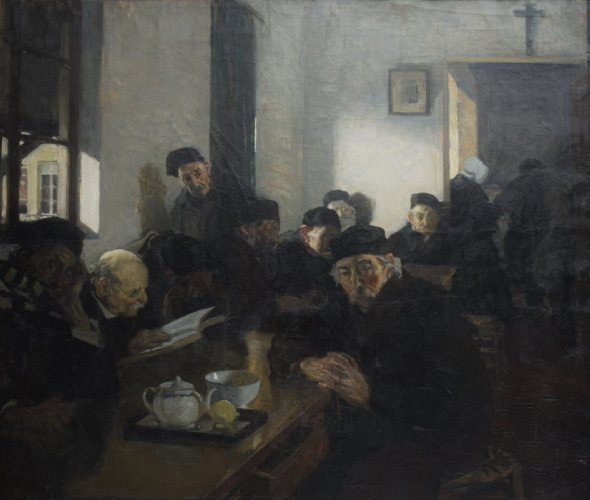Description:
Lucien Simon (1861-1945) belonged to the circle of French painters. He studied in Paris with Didier and Robert-Fleury at the Académie Julian. He was mainly interested in portraiture and religious themes. Together with Charles Cottet and André Dauchez (his brother-in-law, a Breton painter), they formed the “Black School of Painting” – La Bande Noire. They were inspired by Impressionist painting, but used a much darker palette. They depicted the harshness and religiousness of the everyday life of the people of Brittany, whom Simon had the opportunity to meet during his first visit to this region of France in 1890.*
Lucien Simon was known for his masterful portraits depicting people of personal or sociological interest. He depicted them in their characteristic interiors. The painting “Shelter of the Elderly” captures a group scene, a specific portrait of anonymous people. They do not make contact with each other, neither verbally nor visually. In the crowded representation, a psychological study of the helplessness of the elderly was presented.
Description of the painting:
Lucien Simon depicted a group of characters crowded in two adjoining rooms. A woman and a man in the first room are standing, their backs turned to the viewer. In the foreground room, nine elderly men are shown sitting around two tables. They are all dressed in dark-colored attire. No conversations or interactions between them can be seen. The painting conveys a sense of stagnation and silence. Only the figure of an elderly man leaning on the table with folded hands and rosy cheeks looks at us. He, like the others, awaits something.
The viewer’s gaze is drawn to the black wooden cross hanging over the door on the white wall. Brighter elements on the table are also noticeable: a porcelain teapot, a lemon, an empty white bowl, and the figure of a man bent over and reading a book intently. In the context of the title of the painting, “Shelter for the Elderly,” we can interpret it as an allegorical representation of wisdom, experience of life, passing time, and existential questions about the purpose and end of human endeavors. The dead nature in the foreground is undoubtedly meaningful − objectifying.
Sunlight entering the room through the window becomes an alien element, uncontrollable, bringing a breath of awakening life, as if unbecoming of such a scene. It impertinently disturbs the peace of the assembled. It performs a dual function. On one hand, it is necessary for reading a book and is thus used for that purpose by the man. On the other, it reveals the signs of passing time and approaching death hidden under the folds of dark clothes and appearing on the faces of the characters. It allows us to contemplate their fate, as indicated by the title of the work. It is a portrait of abandoned, lonely people deprived of a home. They become a group of strangers united by the inevitability of passing away.


